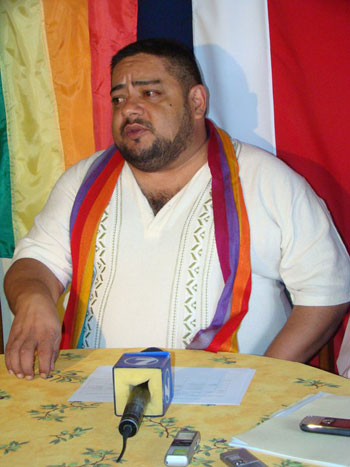A Date with Jao Mapa (Quark Henares, 1999)
Alexa Lindo, from Henares’ early short film A Date with Jao Mapa, is perhaps the prototype of this Henares character. Normal-looking but apparently stricken with an obsession for popular matinee idol turned legendary has-been Jao Mapa, Alexa has deviously planned for herself a date with Mapa, who in the film happens to be an easy-to-get and sex-crazed jerk. The film primarily explores Alexa’s indefatigable fanaticism through what seems to be a not-so-personal video diary where Alexa, speaking directly to the camera, reveals the extent of his insanity.
She belittles the efforts of ordinary fans, declaring her interest for Jao Mapa as “more profound.” The profundity of her adoration is expressed via her stalking the former actor at work, which inevitably leads to him bumping into her, date proposals being offered, a dinner date in an expensive restaurant where what’s spoken is not exactly what’s thought, and an all-nighter that is not as romantic or erotic as what’s expected.
A Date with Jao Mapa has all the faults and all the charms of a student film. Shot in a typical consumer level video camera, the short is not exactly beautiful to look at. There are efforts to make the film look more than just a university project, such as when the camera slowly zooms to show Alexa’s patient face as she waits for Jao Mapa in the restaurant while the rest of the room are idly doing their own business, or when during the film’s climax, clever camera angles manage to add some suspense in the quick surprise. Editing’s functional. Dialogues are too self-aware, too self-consciously witty. Clearly, the film was made with as little money as possible.
The capital spent was mostly composed of wile and creativity, and perhaps, Henares’ very own obsession over the quirks that made Filipino pop culture Filipino. Unlike Henares’ later films which are all plagued by budgetary constraints, studio influence, the burden of expectations for him to be great, or the baggage of being already too involved in the pop culture he delights in, A Date with Jao Mapa is pure and concretely a product of unadulterated ingenuity. One can easily forgive the amateurish qualities of the video because the short has an energy that is still unmatched by any of Henares’ better-produced features.
Henares’ casting of Marie-France Arcilla, or more popularly known as Marnie of the very popular gag show Ang TV, as Alexa is an acknowledgement of his fascination for resurrecting his childhood heroes. Apart from seeing Jao Mapa not as a swoon-worthy leading man but as a man whose glorified past is but a lingering shadow used to bed women, there is a certain excitement seeing Marnie all grown up, acting sophisticated and sexy like some femme fatale from an obscure noir. Perhaps, this is Henares’ self-therapy to absolutely cure him of being swept away by the film and television-fed fantasies of his childhood.
Perhaps the anger that dominates the film’s finale is due to his frustration in seeing and eventually accepting those fantasies that are the cornerstones of the happiness of his growing up dissipate into the very boring reality that all adults have to face and be content with. Rather than making out and making love with just dull fragments of those wondrous icons of the past and quietly accepting them as disappointingly ordinary, he’d rather just kill them, and preserve their greatness as intact and untainted memories.
(Cross-published in Lagarista.)
.jpg)
















































